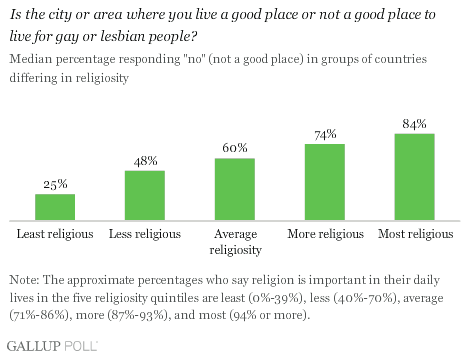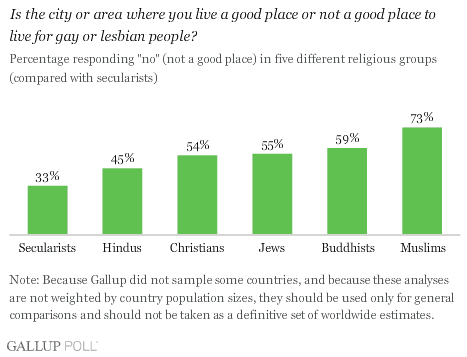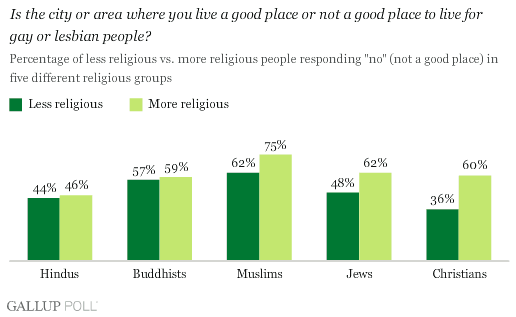This article is the first in a two-part series on religiosity and intolerance. This first article reviews the importance of religion in people's daily lives and their likelihood to say their communities are or are not good places for gays and lesbians to live.
WASHINGTON, D.C. -- Gallup Polls conducted in 129 countries between 2006 and 2008 reveal that in many countries where high percentages of people report that religion is important in their daily lives, people are also highly likely to report that the place where they live is not a good place for gays and lesbians to live.

"Religious" people in this analysis are defined as those who report that religion is important in their daily lives. Using the percentage of "religious" people in a given country, all 129 countries are divided into the five groups, ranging from least to most religious.
Key Findings
1. People who live in countries where more people say religion is important in their daily lives are much more likely than those who live in countries where fewer people say religion is important to say their communities are not good places to live for gays and lesbians.
As the graph shows, the proportion of residents who say their communities are not good places for gays or lesbians to live increases dramatically in countries where more people say religion is important in their daily lives. In the world's least religious countries -- which are predominantly European states -- a median of 25% report that their communities are not good places for gays and lesbians to live. At the other extreme, in the "most religious" countries -- which are predominantly in Africa, Asia, and the Middle East -- a median of 84% perceive their local communities this way.
It's important to note that the world's most religious countries, as defined in this article, tend to be located in much poorer regions than the least religious countries. So to some extent, residents of these countries could be less likely to say their communities are good places for anybody to live.
But these regional differences alone don't account for the connection between religiosity and perceived acceptance of gays and lesbians. Separate analyses within each world region show that citizens of more religious countries are more likely to report intolerance.
2. The percentage of people who say their areas are not good places for gays and lesbians to live varies significantly among the world's major faith traditions. Within most faiths, however, a majority of those who say religion is important in their daily lives perceive their communities as poor places for gays and lesbians to live.
The doctrines and leadership of most of the world's largest religions often take a negative view of same-sex relationships, but specific religions vary in the degree to which they accept gays and lesbians. The members of different religious groups do seem to differ in their reports of community intolerance toward gays and lesbians.
First, only a third of secular respondents -- atheists, agnostics, and others who say they are not religious -- report that their communities are not good places for gays and lesbians to live. However, in four out of the five faith traditions studied, a majority of members describe their communities this way.

Comparing attitudes among respondents who self-identify with the five religions examined here, Hindus are the only group in which less than half say their areas are not good places for gays and lesbians to live. The percentages are somewhat higher among Christians, Jews, and Buddhists. Muslims are most likely to say this is the case. It is worth noting that many of the world's predominantly Muslim countries were excluded from these analyses either because Gallup was not allowed to survey on this topic or because pilot research showed that respondents would be uncomfortable talking about the topic. It is hard to imagine, though, that people living in countries where this question was not asked would report unusually low levels of intolerance.
However, there is a great deal of variation in acceptance of gays and lesbians from region to region among those who affiliate with the same religion. Among the 342 Muslim respondents living in EU countries, only 24% report that the place where they live is not a good place to live for gays and lesbians. Among Muslims living outside the European Union, the figure was a much higher 74%. Similarly, among the more than 17,000 Christian respondents in the European Union, the value was 27%, compared with 62% outside the European Union.
3. Within most faiths, a majority of those who say religion is important in their daily lives say their communities are not good places for gays and lesbians to live.
What happens when comparing members of each faith who say religion is important in their daily lives with those who do not say so? With the exception of Hindus and Buddhists, members of the five faiths examined who say religion is important in their daily lives are more likely than those who don't say so to report that their communities are not good places for gays and lesbians to live. The connection between religiosity and tolerance is strongest among Christians. The gap between religious and less religious Christians is 24 percentage points. For Muslims and Jews, the tolerance gap averages half this amount. For Hindus and Buddhists there is virtually no gap at all.

Bottom Line
While many religious institutions have historically frowned upon same-sex relationships, a global view of religiosity and perceived intolerance toward gays and lesbians suggests that the robust association between religiosity and intolerance toward gays and lesbians does vary somewhat from religion to religion. Worldwide there is no one answer to the question of whether religiosity is associated with intolerance toward gays and lesbians.
Survey Methods
Results are based on telephone and face-to-face interviews conducted between 2006 and 2008 with about 1,000 adults in most countries (with a sample size range of 446 to 2,006). Confidence intervals vary widely based on the sample sizes of specific groups. However, for the results involving groups of countries that vary in religiosity level, confidence intervals were always less than ±1%. In addition to sampling error, question wording and practical difficulties in conducting surveys can introduce error or bias into the findings of public opinion polls.
